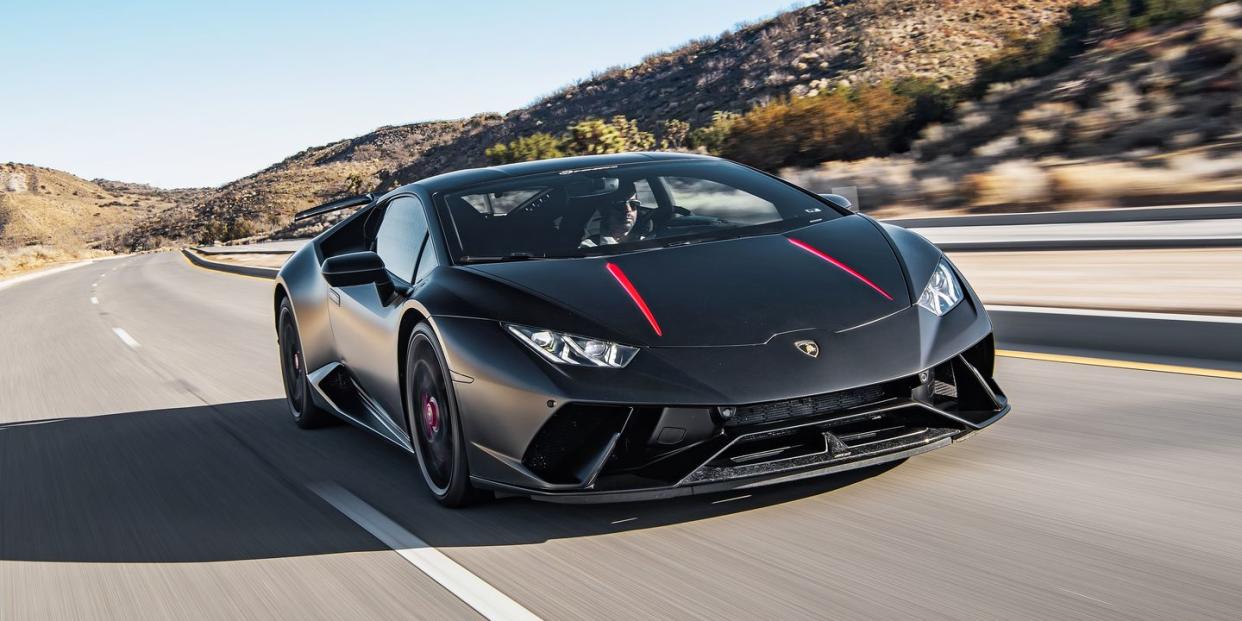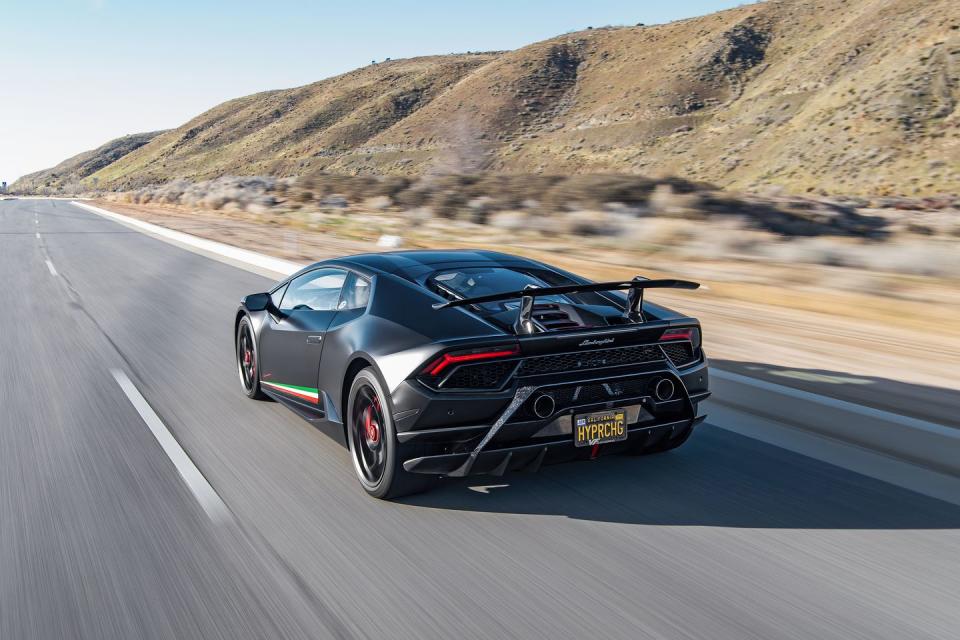VF Engineering Lamborghini Huracán Is a Beast with Manners

When we first met Nik Saran, the owner of VF Engineering, at The Motoring Club in Los Angeles, we didn't expect to be track testing his company's supercharged Lamborghini Huracán Performante a week later. Usually guys like Saran are full of excuses why we can't test their product. We've heard them all. "We're still tuning it." "I wish you had asked last week. We just sold it." Or our favorite: "We'd like to, but it's booked solid to appear at a bunch of car shows."
But with Saran, the conversation went something like this. Can we drive it? Yes. Can we test it? Sure. How about next Monday? Sounds good, where? Way out in the Mojave Desert about 150 miles from your shop in Orange County. I'll drive it out there.

After supercharging cars in the United Kingdom for four years, Saran imported himself to Southern California and opened VF Engineering in Anaheim in 2000. Now the company has a 15,000-square-foot shop with a chassis dynamometer and 10 employees, and the ability to tune dozens of models, including the new Toyota Supra. It also has supercharger kits for 25 different European models and sells about 200 a year to enthusiasts all over the world. Buyers can either ship their car to Anaheim for installation, or Saran will find a shop in their area to perform the work.
Five years ago, his kits for Porsche 911s and BMW M3s, which employed a Vortec centrifugal supercharger, were the most popular. Today about half the kits VF sells are its VF8XX for V-10–powered Lamborghini Huracáns and Audi R8s. "We've been supercharging the V-10 for over 10 years," he said. "The idea is to take a supercar to the power of a hypercar."

Turning a V-10 to 11
VF8XX stands for 800-and-something horsepower. According the Saran, on California's 91-octane pump gas, the kit takes the Performante's engine from its stock 631 horsepower to 830. He said it makes up to 20 horsepower more, however, on the 93- or 94-octane gas available in other parts of the country and 887 horsepower on the even higher octane fuel readily available in Europe. And that's with the roots-type Eaton TVS2300 supercharger producing a maximum of just 6.5 psi of boost. "Reliability is a big deal for us," Saran said. "We won't go over 6.5 psi, even if the customer wants it." The kit does, however, void the Lambo's factory warranty, however. VF's warranty covers the kit, which costs $36,995 plus $7000 for installation, for two years and unlimited miles.
At the V-10's 8900-rpm redline, the 2.3-liter supercharger is churning 22,000 rpm and requires about 50 horsepower to spin. Its aluminum case sits on both a manifold VF manufactures and an air-to-water intercooler. The V-10's compression ratio remains 12.7:1. The rest of the kit consists of a Y-shaped plenum that is fed by the factory throttle bodies, as well as air filters and airboxes. VF also recalibrates the engine's computer, adding fuel and modifying the spark curves, and replaces the harmonic damper and crank pulley to accommodate a seven-rib supercharger belt in place of the engine's stock five-rib belt. The Lamborghini's all-wheel-drive system and seven-speed dual-clutch automatic transmission are untouched.

The whole package adds about 100 pounds to the car, Saran said, and the installation looks clean enough to have come from the factory, which is important on a car with a clear engine cover. The blower, as well as all the other bits, are always on display. When we mentioned that the blower pulley sits just a few millimeters from the Lambo's firewall, Saran didn't blink. "Clearance is clearance," he said.
Blown Away
The end result feels, sounds, and performs as if the VF Lambo's upgrades were installed on the production line in Sant'Agata. This is not a temperamental beast, and the blower is shockingly quiet, lacking the prominent whine and whistle produced by, say, a blown Dodge Challenger Hellcat. There is a bit more induction noise than stock and bit of resonance at a steady 3000 rpm, but the supercharged V-10 idles unassumingly . The 5.2-liter V-10 still revs fast and clean. The throttle calibration is right on, with sharp response and explosive power anywhere on the tach. But the engine doesn't feel unnecessarily high strung or overstressed, and it can easily settle down for an 80-mph cruise.

Don't misunderstand; it's still loud as hell. But all Huracáns are. You can hear the car ripping through its gears from a half-mile away, and it pops and bangs on the overrun like supercars do these days. At wide-open throttle, its cabin is filled with 95 decibels of mechanical thunder, but that backs off to a livable 75 decibels at 70 mph.
Before Saran handed over the key, we watched him fill the Lambo's tank with pump gas. Full of fuel, it weighed 3659 pounds. That's 230 pounds more than race-seat equipped Huracán Performante we tested a few years ago but just 41 more than a Huracán Evo. The VF Huracán's acceleration times also split the difference between those two production models. Equipped with launch control, all-wheel drive, and massive Pirelli P Zero Corsa tires, sized 245/30R-20 in front and 305/30R-20 at the rear, the supercharged Performante shot to 60 mph in 2.4 seconds with a quarter-mile pass of 10.1 seconds at 139 mph. We recorded a 2.3-second 60-mph dash and a 10.2-second quarter-mile at 136 mph in a stock Performante. The Huracán Evo posted a 2.5-second run to 60 mph and did the quarter in 10.4 at 135 mph. The higher trap speed in the quarter is a clear sign that the blower Lambo is making a bit more power than stock.

Given more space to show off the power advantage, the VF car leaves the factory machines for dead. It hits 150 mph in 12.1 seconds, or 2.4 seconds quicker than the Huracán Evo. Its 20.6-second pull to 180 mph is 2.6 seconds fleeter than a stock Performante's. It's also considerably quicker from a rolling start, taking just 2.9 seconds to accelerate from 5 to 60 mph. The stock Performante requires 3.1 seconds and the Evo needs 3.4.
More impressive is the VF Huracán's solidity. Our test car had more than 6000 miles on it, and it has been supercharged since new. Yet, it never hiccupped, felt fragile, or got finicky. Power-sapping heat issues were never a problem. After a full day of testing and hard driving, after countless tire-spinning launches and 8900-rpm gear changes, Saran jumped behind the Lambo's steering wheel and drove 150 miles home through the wide-open Mojave and clogged L.A. freeways.
No excuses. Just a car that performs exactly as it should.

You Might Also Like

 Yahoo News
Yahoo News 
